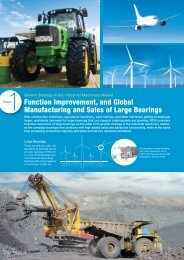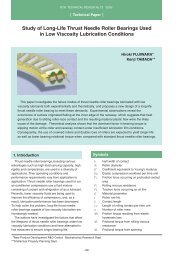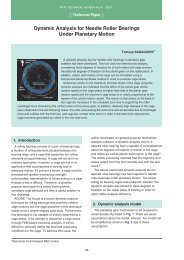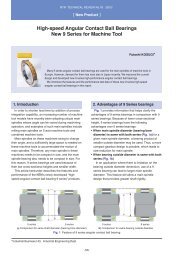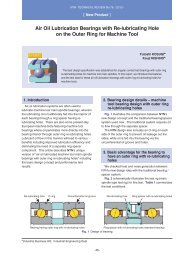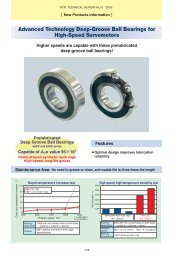Special Issue; Products for Industrial Machinery - NTN
Special Issue; Products for Industrial Machinery - NTN
Special Issue; Products for Industrial Machinery - NTN
Create successful ePaper yourself
Turn your PDF publications into a flip-book with our unique Google optimized e-Paper software.
<strong>NTN</strong> TECHNICAL REVIEW No.742006<br />
New Product <br />
Minimum Quantity and Cooling Jet Lubricated<br />
Angular Contact Ball Bearings <strong>for</strong> Machine Tool<br />
Mineo KOYAMA<br />
Minimum Quantity and Cooling Jet (MQCJ) angular contact<br />
bearings feature a unique jet lubrication system. The design<br />
incorporates a special inner ring design, with a cooling groove<br />
combined with special geometry <strong>for</strong> directing lubricant to allow an<br />
optimally small amount of lubricant to reach the raceway, in order<br />
to minimize power losses from friction torque. It was developed in<br />
response to market demands <strong>for</strong> machine tool spindles with<br />
increased speed capability coupled with high rigidity. Its practical<br />
use has been demonstrated by having achieved a dmn 3.6 million<br />
with fixed-position preloading. This technical review paper is<br />
intended as an overview of its development and design.<br />
1. Introduction<br />
Needs have been mounting <strong>for</strong> faster machine tool<br />
main spindles. This trend is even more apparent with<br />
the main spindles of machining centers <strong>for</strong> machining<br />
dies because of the desire to realize machine tools<br />
that are capable of providing higher quality finished<br />
surfaces of workpieces and to improve machining<br />
efficiency. To address these needs, attempts to<br />
develop higher speed main spindles by using air-oil<br />
lubrication and oil-mist lubrication have been<br />
undertaken. In 2004, <strong>NTN</strong> developed a novel jet<br />
lubrication mechanism that shoots lubricating oil to a<br />
scoop <strong>for</strong>med on the inner ring end face, realizing<br />
both high-speed operation at 5 million dmn with a<br />
constant pressure preloading system <strong>for</strong> angular<br />
contact ball bearings and low power loss that is<br />
comparable to the power loss with air-oil lubrication.<br />
To satisfy market needs <strong>for</strong> higher bearing speed, we<br />
have recently developed angular contact ball bearings<br />
based on a fixed-position preloading system, and the<br />
newly developed bearings have realized high speed<br />
operation of 3.6 million dmn while ensuring preloading<br />
at the initial stage of bearing operation. This report<br />
describes the features of these bearings, and the<br />
results of evaluation testing.<br />
The author has named this novel jet lubrication<br />
system MQCJ (Minimum Quantity and Cooling Jet)<br />
lubrication.<br />
2. Features of the MQCJ Lubrication<br />
Mechanism<br />
2.1 Jet lubrication <strong>for</strong> the inner ring<br />
The construction of an MQCJ-lubricated angular<br />
contact ball bearing is illustrated in Fig. 1. When the<br />
main spindle runs at a higher speed, the preload<br />
increases because of expansion on the inner ring due<br />
to centrifugal <strong>for</strong>ce as well as because of temperature<br />
differences across the inner ring and outer ring due to<br />
heat generation on the bearing. If jacket cooling is<br />
provided, the outer-ring side is actively cooled.<br />
However, because the inner-ring side is<br />
disadvantageous in terms of heat radiation compared<br />
to the outer-ring side, the temperature on the innerring<br />
side is higher than that on the outer-ring side, and<br />
the thermal expansion on the inner-ring side becomes<br />
greater. As a result, the preload on the bearing<br />
increases unavoidably. The author’s lubrication<br />
mechanism is characterized in that lubricating oil is<br />
first shot to the scoop <strong>for</strong>med on the inner-ring end<br />
face to actively cool the inner ring in order to inhibit<br />
preload buildup.<br />
2.2 Application of the minimum quantity of<br />
lubrication mechanism to the rolling<br />
contact surface<br />
Conventional jet lubrication arrangements have the<br />
drawback that their power loss is greater due to<br />
<strong>Industrial</strong> Engineering Dept. <strong>Industrial</strong> Sales headquarters<br />
-24-


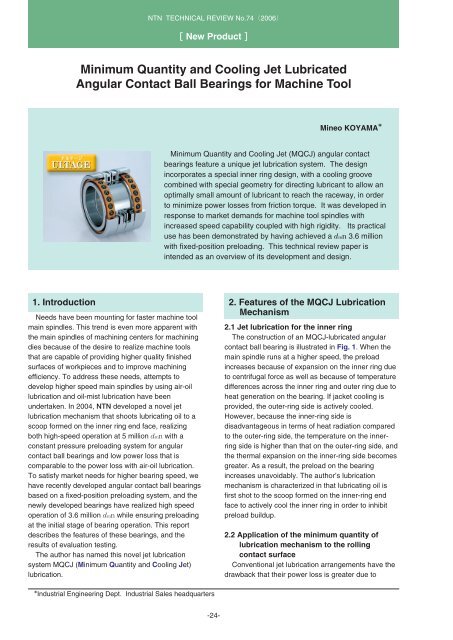
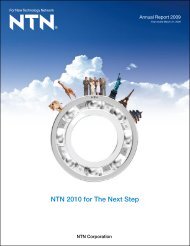
![[New Product] Unit Products for Office Equipment - NTN](https://img.yumpu.com/27154451/1/184x260/new-product-unit-products-for-office-equipment-ntn.jpg?quality=85)
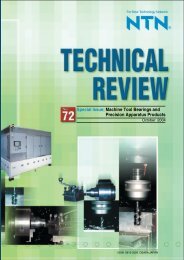
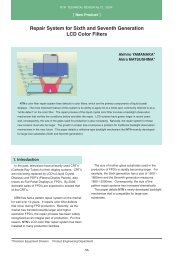
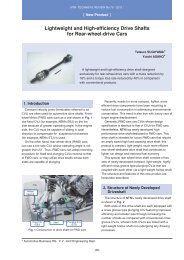
![[New Product] Development of Oil-impregnated Sintered ... - NTN](https://img.yumpu.com/27154427/1/184x260/new-product-development-of-oil-impregnated-sintered-ntn.jpg?quality=85)

